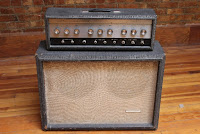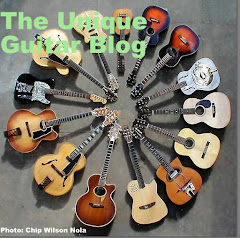 |
| 1949 Harmony Patrician |
The first guitar I ever owned was a late 1940's archtop Harmony Patrician. Though the neck said "Steel Reinforce", the heavy Black Diamond strings on that guitar caused the neck be about a half an inch above the neck at the 12th fret.
Although it was a challenge to play, I learned the basic chord patterns and got a start with that instrument. Old Harmony Guitars will always have a warm place in my heart.
 |
| 1920 Harmony Uke |
During the early part of the 20th Century the ukulele craze hit college campuses. Young men with bulky raccoon coats and ukuleles could be seen serenading girls. It was during this era, 1916 to be exact, that Sears, Roebuck and Company purchased Harmony so that they could corner the ukulele market.
 |
| 1920's Sears Catalog |
The man leading Harmony in those early days was Joseph Kraus.
Sears retained him as chairman of the company through 1940.
 |
| Harmony Factory |
Harmony was possibly the first company to build a long neck Pete Seeger style banjo, even before Pete's Vega version was made.
By 1923 Sears was selling over a quarter of a million instruments a year. Seven years later this figure doubled.
 |
| '29 Harmony Smeck Vita Uke |
In 1928 the company introduced Roy Smeck models of ukuleles and guitars. This multi-instrumental string player was very popular at the time. His name was also added to a line of lap steels and electric guitars.
Some of the brands that are actually Harmony instruments include the brand names Holiday, Vogue, Valencia, Johnny Marvin, Monterey, Stella among others.
 |
| 1950's Harmony H-1311 Cremona |
All of the "arched top" guitars that Harmony produced did not have an actual carved top, like the ones expertly carved on high end guitars. Instead the wood for the top, usually spruce, was dampened and placed in a heated form, then pressed into an arched shape.
During the early 1930's Sears bought brand names owned by the bankrupt Oscar Schmidt Company, which included La Scala, Stella and Sovereign. Stella guitars were a popular guitar for Blues players.
 |
| Harmony Exhibit - Lillibridge Gallery |
 |
| Very Early photo of the Harmony Factory |
Like many other guitar companies, Harmony sales peaked in 1964 to 1965 selling 350,000 instruments annually. However foreign competition crept in and domestic sales declined.
| H-54 '63 Rocket & 60 H-75 |
Harmony electrics took their queue from Gretsch and Gibson. Most of the guitars pickups were manufactured by Rowe Industries Inc. also known as Rowe DeArmond, which was based in Toledo, Ohio.
Vintage guitar magazine price guide puts the current value of a Harmony H76 at between $1100 and $1200 USD. It sold for $200 to $300 new.
 |
| 1939 Harmony H-1248 |
 |
| Sound Project aka Lectrolab |
Many of the Harmony/Silvertone amplifiers were made by Sound Projects of Cicero, Illinois.
 |
| 1947 Harmony 200 aka 1300 amp |
While other Harmony Amplifiers was made by the Valco Company.
 |
| Harmony H-400 student amp |
The Harmony H-400 series were updated tube amps made during the 1960's.
 |
| Silvertone Twin Twelve model 1484 |
These Silvertone amplifiers are perhaps the ones that most of us remember.
Harmony Guitar Company shuttered its doors in 1975. By these years the manufacturing had ceased and the company was mainly importing and relabeling Asian manufactured instruments.
In the early 2000's the Harmony trade name was sold to the Westheimer Corporation which briefly continued to market imported “reissue” Harmony guitars.
During the 1940’s through the 1960’s Harmony produced a line of archtop guitars These guitars were more popular with Big Band players of the 40's and 50's.
 |
| 1960's Harmony Sovereign |
 |
| Harmony Headstocks |
From the photo you can see “Steel Reinforced Neck. Most Harmony guitar necks were not adjustable.
 |
| Harmony Stella H-930 |
On many of the less expensive instruments, such as the Harmony made Stella. The fret markers were merely painted in the appropriate places. On some instruments the pickguards were painted directly on the soundboard. The tailpieces on the lower end models were made of cheap pressed metal. Some even had the tailpieces, bridges, and pick guards screwed into the wood.
 |
| Harmony Patrician |
Harmony guitars that survived from the 1940’s, although made of pressed wood, were very nice instruments and were made of solid spruce or mahogany. Even lower end models were usually made of solid birch. The tops were never laminate.
 |
| Catalina H-1220 and H-1221 |
Perhaps the more unusual Harmony arched top guitars were the two tone Catalina Series guitars. These were manufactured between 1955 through 1958.
 |
| 1931 H-1502 and 1971 H-930T |
Harmony was one of the few manufacturers to include a tenor guitar in their offerings. In fact there were 34 different models offered from 1931 through 1971.
 |
| 1944 Harmony H-165 |
Harmony also offered a solid wood, all mahogany alternate to those all mahogany Martins sold in the 1940's. The H-165, made from 1944 to 1958 featured a 'figure 8' shaped body with rounded edges. The body shape changed in 1958, and this guitar was offered through 1971.
 |
| Harmony Stratotone H-44 |
One of the more unique electric Harmony guitars that was offered beginning in 1952, was the Stratone H-44. This guitar featured a neck-thru body construction, with "wings" added to form the cutaway shape. It came in a one or two single coil pickup version.
 |
| H-45 and H-46 Stratone Mars |
 |
| 1963 H-14 and 1963 H-15 |
 |
| 1967 Harmony H-60 Meteor |
The Harmony H-60 Meteor was the company's answer to Gibson's ES-330 and Epiphone's Casino, in appearance only. While this guitar came with the 330's double cutaway hollow body, which was made of laminated maple and arched. But the Harmony guitars neck was bolted on to the body The twin pickups were enlarged DeArmond Gold Foil single coils pickups. The H-60 Meteor came with or without a Bigsby vibrato. This guitar was offered until 1970.
 |
| 1972 H-682 Rebel |
 |
| 1967 H-19 Silhouette |
From 1963 to 1967 Harmony's offered the H-19 "The Silhouette", which resembled Fender's Jazzmaster/Jaguar's body shape. It came with a Hagstrom vibrato and twin DeArmond Gold Foil single coil pickups that were mounted on top of the pickguard.
From as early as 1947, Harmony made some impressive Jazz style guitars.
 |
| 1951 Harmony H-60 |
This was a gorgeous instrument and featured a set-in neck, which was not adjustable. In later years, Harmony used to H-60 designation for it's Meteor series.
 |
| Harmony H-62 |
 |
| H-63 Espanada |
Beginning in 1968 this changed to white/black/white binding. In 1960, the bodies depth was diminished to two and three quarter inches.
Harmony's line resembled Gretsch and Gibson guitars, but did not have the complicated switching of a Gretsch, nor did the Harmony versions have the quality of Gretsch and Gibson. But for the money these were quite nice instruments.
 |
| Harmony - Fender |
Ironically when Fender was trying to break into the acoustic guitar market, the first guitar line they offered in their catalog was made by Harmony guitars with the Fender brand on the head stock.
| Baldwin 801C |
When Baldwin purchased Burns of London and Gretsch guitars, they did not have a classical model. So they turned to Harmony manufacture “Baldwin” classical guitars.
 |
| Harmony H-173 |
The Harmony H-173 Classic nylon string model is the same guitar as the Baldwin 801C, but the H-173 did not come with the Prismatone piezo pickup, nor did it have a rosette. It was a very plain student style instrument. Both Jerry Reed and Willie Nelson were given 801C guitars and matching amplifiers by Baldwin Guitars.
 |
| Baldwin Prismatone Piezo Pickup |
Guitarist Jerry Reed loved it, because it came with a Prismatone Pickup. Reed purchased three of these instruments and took them to a Nashville music store to have a luthier install cutaways on each of them.
In 2018 the rights to Harmony's tradename were acquired by Bandlab Technologies, the Singapore based company that created Cakewalk software for recording. Bandlab was started in Boston, then acquired by Gibson until 2017, and then sold to Bandlab.
 |
| 2017 Harmony Guitar Line Up |
In 2017 Bandlab reintroduced Harmony guitars The guitars are now made in China. Though the names are similar to some of the older Harmony electric models, the shapes, and pickups have changed.
 |
| 2019 Harmony 8418 Amp |





















